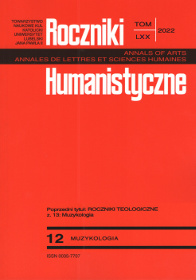Krzysztof Trebunia-Tutka’s Numerical Notation for Learning the Violin in Podhale: Understanding the Model
Abstract
A numerical notation was recently published for the learning of fiddle melodies in the Podhale region. This work – containing material from the history of the region, as well as music writing and numerical notation – stands out, in that its author (Trebunia-Tutka) is a local musician. Why and for whom is he writing? As a teacher, he is writing first and foremost for learners of music. Thus, this publication offers an opportunity to reflect upon the relationship between writing and orality in Podhale music. Comparing recordings of performances with the numerical notation of the melody gives insights into the author’s own choices in writing, and allows for the distinguishing of standards in musical variations. Therefore, this analysis may shed some light on musical grammar. This paper explores the hypothesis that the numerical notation, as a simplified version of the melody, gives reason to think that its author has a “template” in mind (Lortat-Jacob 93-111).
References
Arom, Simha. « Modélisation et modèles dans les musiques de tradition orale ». Analyse Musicale, no 22, 1991, p. 67 78.
Carton, Jean-Paul. The French Review, édité par Michel Nominé et al., vol. 79, no 5, 2006, pp. 1080 81.
Charles-Dominique, Luc. Les « bandes de violons » en Europe: cinq siècles de transferts culturels des anciens ménétriers aux Tsiganes d’Europe centrale. Brepols, 2018.
Chybiński, Adolf. O polskiej muzyce ludowej: wybór prac etnograficznych. Polskie Wydawnictwo Muzyczne, 1961.
Cooley, Timothy J. Making music in the Polish Tatras: tourists, ethnographers, and mountain musicians. Indiana University Press, 2005.
Cugny, Laurent. Théorie des musiques audiotactiles et notation. (2019). HAL Archives Ouvertes, hal.archives-ouvertes.fr/hal-02098957.
Dauphin, Claude. « Rousseau, Jean-Jacques : Dissertation sur la musique moderne (1743) ». Notice du Dictionnaire des écrits de compositeurs, Dicteco, 2018, dicteco.huma-num.fr/book/ 36305.
Kenny, Elizabeth. « Revealing Their Hand: Lute Tablatures in Early Seventeenth-Century England: Lute Tablatures in Early Seventeenth-Century England ». Renaissance Studies, vol. 26, no 1, février 2012, pp. 112 37.
Kotoński, Włodzimierz. « Uwagi o muzyce Podhala ». Muzyka, no 7-8 (40-41), 1953, pp. 43-58.
Lortat-Jacob, Bernard. Petits pays, grandes musiques: le parcours d’un ethnomusicologue en Méditerranée. Société d’ethnologie, 2020.
Małanicz-Przybylska, Maria. Między dźwiękami Skalnego Podhala: współczesna góralszczyzna. Wydanie 1. Wydawnictwa Uniwersytetu Warszawskiego, 2018.
Mierczyński, Stanisław. Muzyka Podhala. Polskie Wydawnictwo Muzyczne, 1973.
Molino, Jean. « Qu’est-ce que l’oralité musicale ? » Musiques. Une Encyclopédie pour le XXIe siècle, vol. 5 : L'unité de la musique, Actes Sud / Cité de la musique, 2007, pp. 477 527.
Ribouillault, Claude, et al. Violons du Poitou répertoire de danses en tablatures: cahier de Pierre Martin, vers 1880. UPCP-Metive, 2003.
Scaldaferri, Nicolas. « Pourquoi écrire les musiques non écrites ? Esquisse d’une anthropologie de l’écriture de la musique ». Musiques. Une Encyclopédie pour le XXIe siècle, par Jean-Jacques NATTIEZ, vol. 5 : L'unité de la musique, Actes Sud / Cité de la musique, 2007, pp. 627 68.
Trebunia-Tutka, Krzysztof. Muzyka Skalnego Podhala: podręcznik do nauki muzyki góralskiej. Polskie Wydawnictwo Muzyczne, 2021.
Copyright (c) 2022 Roczniki Humanistyczne

This work is licensed under a Creative Commons Attribution-NonCommercial-NoDerivatives 4.0 International License.





